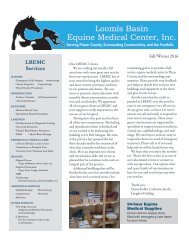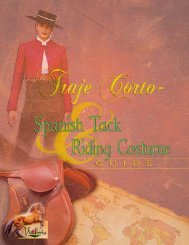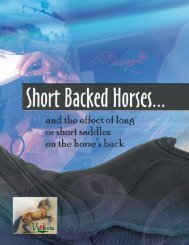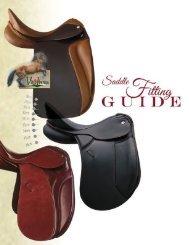Viva Iberica's The Cobra
In this history of an ancient tradition born of threshing grain, Richard Lust of www.Viva--Iberica.com, explains the harnessing and use of a full complement of mares or, The Cobra.
In this history of an ancient tradition born of threshing grain, Richard Lust of www.Viva--Iberica.com, explains the harnessing and use of a full complement of mares or, The Cobra.
Create successful ePaper yourself
Turn your PDF publications into a flip-book with our unique Google optimized e-Paper software.
<strong>Cobra</strong><br />
<strong>The</strong>
<strong>Cobra</strong><br />
<strong>The</strong><br />
By Richard Lust<br />
Yeguada Iberica & www.viva-iberica.com<br />
<strong>The</strong> <strong>Cobra</strong> is a group or string of mares,<br />
often called a lote de yeguas in Spain.<br />
History<br />
In days gone by a lote de yeguas (group of mares) in Spain were sometimes used for threshing grain.<br />
<strong>The</strong>y would be linked together with neck collars to a central pole and walked or trotted as a group in a circle<br />
in order to thresh the grain from the chaff. <strong>The</strong> use of simple neck collars was traditional.<br />
Usually a small bell would be fitted to each neck collar so the farmer could hear when the mares were<br />
working, if they had stopped, needed speeding up or maybe given a break. Sometimes the bells were<br />
selected to give a different timbre so the farmer would know which sound related to each mare.<br />
Today when we put a <strong>Cobra</strong> together at our stud it is fascinating to watch the reaction of our stallions<br />
because while taking little notice of the mares being around, as soon as they hear the bells they know the<br />
mares are off and they want to join them.<br />
Traditionally tails were trimmed to hock level, to keep from dragging in the chaff and picking up debris. Today<br />
the reason used is so that the judge can better see their movement and conformation in competition! Most<br />
breeding mares in Spain would have the tops of their tails clipped but an old tradition sometimes seen is<br />
where they would have a ‘ring’, or rings, shaved just below the base of the shaved region where the hair<br />
begins. If connected together in a preferred order, the mare furthest from the handler, the ‘lead’ mare,<br />
would have one ring shaved into her tail, the next two rings, the next three, and so on. Farm workers could<br />
then see in which order the mares needed to be linked because occasionally they would work better together<br />
in a certain order and it usually paid to have the least lazy on the outside!<br />
Note: In Spain, PRE mares also have their manes trimmed when competing.<br />
Competition<br />
<strong>The</strong> <strong>Cobra</strong> is important in competition throughout Spain for breeders of the<br />
Purebred Spanish Horse (PRE) and is slowly becoming a feature at National PRE breed shows<br />
in other countries around the world. Usually studs cannot be considered for ‘Best Breeder’<br />
awards unless they enter a <strong>Cobra</strong>.<br />
Although stallions are traditionally ridden in Spain a stud’s mares are generally considered to<br />
represent the true value or success of the breeder – something not often fully understood outside of Spain.<br />
A common question asked is “how many mares have you got” not how many stallions.<br />
Serious traditional PRE breeders have long tried to produce a ‘type’ with similar characteristics, rather than a<br />
hotchpotch of shapes, sizes and colours. PRE stock has and should conform to breed type and conformation,<br />
but in competition a group of mares bred at the same stud and matching in size, type and colour will often<br />
gain higher marks.<br />
Three mares are shown together and although they are judged individually and as a group, traditionally the<br />
overall ‘picture’ is important. <strong>The</strong>y should work obediently in harmony, although some ‘chispa’ (sparkle) is<br />
appreciated. Good movement is important for maximum points. <strong>The</strong>y are shown at walk and trot and should<br />
work in a harmonious and straight line, finishing by standing still, for the judge’s closer inspection.<br />
Use a long lead rope, traditionally this is plaited leather, connected to the first mare’s neck collar, then<br />
connected by a short leather strap and buckle to the next mare’s collar, and so to the third mare’s collar.<br />
In competition it is best not to use head collars as the judge needs a clear view of each mare’s head. This is<br />
also traditional. Also in the world of horse presenters the best trained <strong>Cobra</strong> and the best handlers respect<br />
the skill of a good presentation without resorting to head collars.<br />
Training a <strong>Cobra</strong> or Lote de Yeguas<br />
If your mares are inexperienced in understanding your voice, or leading well, it would be best to begin<br />
your training with each mare individually.<br />
Your mare should be able to work obediently on the lunge and understand simple voice commands; to walk,<br />
trot and stop and the relevant transitions up a down. Remember to modulate the expression in your voice,<br />
which is much more important than relying on ‘words’. Use mostly ‘upwards’ sounding commands for<br />
upwards tempo, i.e. standing to walk, walk to trot, with a softer ‘downwards’ sound when coming down from<br />
trot to walk, and usually a longer more drawn out ‘downward’ sound to stop. Sometimes a sharp command<br />
to stop is more effective, especially when demonstrating a group of 5 or more mares (not in competition)!<br />
With patience you can help each mare understand when you are speaking specifically to her not the entire<br />
group and this can be achieved with patience by saying her name clearly each time you give her an<br />
<strong>Cobra</strong><br />
<strong>The</strong><br />
Page 2 www.webshop.viva-iberica.com Page 3
Granero IV and his mares<br />
Granero IV<br />
<strong>Cobra</strong> of four in training (head collars are not used in demonstrations). From left to right: Moraleja,<br />
Brincadora XV, Seductora XVII, Oretana III, all bred by Yeguada Iberica.<br />
Richard, Granero IV,<br />
and his cobra of three mares;<br />
Brincadora XV, Oretana III,<br />
Seductora XVII.<br />
Encantadora V, bred by Yeguada Iberica,<br />
and used in <strong>Cobra</strong>s. Three rings in her<br />
tail, so in a <strong>Cobra</strong> of three, she would<br />
perform next to her handler.<br />
Yeguada Iberica’s<br />
Lote de Tres<br />
Yeguada Iberica’s cobra of thhree with foals at their sides<br />
Granero working in hand<br />
<strong>Cobra</strong><br />
Page 4 www.webshop.viva-iberica.com Page 5<br />
<strong>The</strong><br />
Yeguada Iberica’s Lote de Quatro
instruction but you have to build a rapport and know your mares well if you are not going to confuse the<br />
entire group. Being able to do this can be a great help if you are ever demonstrating more than three mares<br />
or handling them from the back of a ridden horse.<br />
Once each mare responds promptly to your requests in a relaxed way you are ready to put them together.<br />
I place the most attentive and responsive mare furthest away from me. <strong>The</strong> more ‘novice’ next to me, with<br />
the least attentive or perhaps slowest to respond in the centre. If you have a mare with a short attention span<br />
she will usually work better in the centre and follow those on each side of her!<br />
On your first attempt it is probably safer to fit each mare with a head collar and connect them to these,<br />
including your own lead rope. Once mastered you could proceed to connecting the three mares by their neck<br />
collars while controlling just your nearest mare by her head collar. Once you have mastered this then try using<br />
neck collars only on all the mares.<br />
Carry a long stick. Traditionalists may use a stick from the quince tree, otherwise a Piaffe whip or lunge whip<br />
with most of the thong removed. This is not a weapon and should only be used as an extension of your arm<br />
to guide and help train your lote to stop together in a straight line, or to encourage a slow to respond mare.<br />
NOTE: A.N.C.C.E. 2013 RULES AND REGULATIONS FOR CONFORMATION - FUNCTIONAL COMPETITIONS FOR PRE HORSES: Article 31. Handlers and riders - 8.2.<br />
<strong>The</strong> use of whips, lashes or sticks is permitted, provided they do not exceed one meter eighty (1.80 meters) in length, including the lash, except for the <strong>Cobra</strong><br />
Sections, in which longer whips are permitted, but with the lash tied up.<br />
CHAPTER VI. HORSES, BREEDERS, GROOMS/PRESENTERS, AND RIDERS - Article 26 (e) <strong>Cobra</strong>s in sections 13 and 14 shall exclusively be made up of mares eligible<br />
for sections 7 to 11, that is to say, aged 4 years and over. Requirements for mares taking part in the cobra section are exactly the same as those required<br />
for participation in an individual section. f) In sections 13 and 14, when the make-up of a cobra must be changed once the entries have closed, and always<br />
prior to the reception deadline, only one of the mares in a cobra may be substituted in the case of section 13, and two in the case of section 14. If there has<br />
been no change, should one of the components of the cobra suffer an injury during the competition, this horse may be substituted by another mare entered<br />
in one of the adult mare sections and that has been on the grounds from the inception and beginning of the event competition. As previously established for<br />
all cases, all horses must belong to the same stud arm at the time of entry.<br />
<strong>Cobra</strong> Exhibitions<br />
You can exhibit (but not in competition) greater numbers, say 4 or more mares. Sometimes in Spain<br />
handlers have been seen demonstrating 20 or more mares.<br />
Clearly to do this your mares must be well attuned to your voice and respond immediately, with the mare<br />
furthest away from the handler being very attentive, responsive and reliable.<br />
In exhibitions top handlers will canter their <strong>Cobra</strong>s, have them walking backwards in line or even finish a<br />
show by full-passing out of the arena.<br />
At Yeguada Iberica we sometimes exhibit 3 or more mares while riding one of the stud’s stallions and a feature<br />
of our exhibitions includes the ridden horse performing Piaffe in slow pirouette with the mares keeping<br />
pace on the circle at walk. Sometimes we may finish with the mares wrapping around the stallion in a circle,<br />
thanking each in turn, before they walk backwards into a straight line to end the show.<br />
For many years Moraleja, one of the grey mares at Yeguada Iberica, used to lead on the outside of the group<br />
and you would often see her left ear turned towards Richard while her right ear faced forwards. She would<br />
always listen for and respond to the quietest request. Now her daughter Brincadora XV carries on the<br />
tradition today, nearly always with one ear turned listening for Richard’s voice.<br />
<strong>Cobra</strong><br />
<strong>The</strong><br />
Page 6 www.webshop.viva-iberica.com Page 7<br />
Always listening
©COPYRIGHT: 2016 Yeguada Iberica®<br />
Photographs are reproduced with the permission of Richard Lust. Photos may not be copied or reproduced<br />
without the owner’s express permission.<br />
Publication Design by www.BTLDesigns.com<br />
<strong>Viva</strong> Iberica / Yeguada Iberica, Apartado de Correos 74, 02500-Tobarra, (Albacete), España<br />
E-mail: info@viva-iberica.com<br />
Additional information is available<br />
www.viva-iberica.com<br />
Page 8<br />
<strong>Cobra</strong><br />
<strong>The</strong>

















